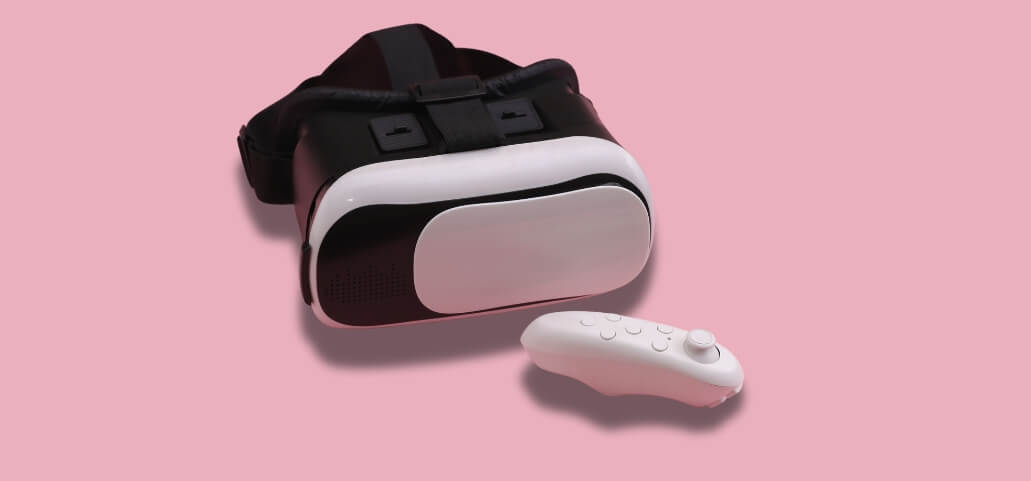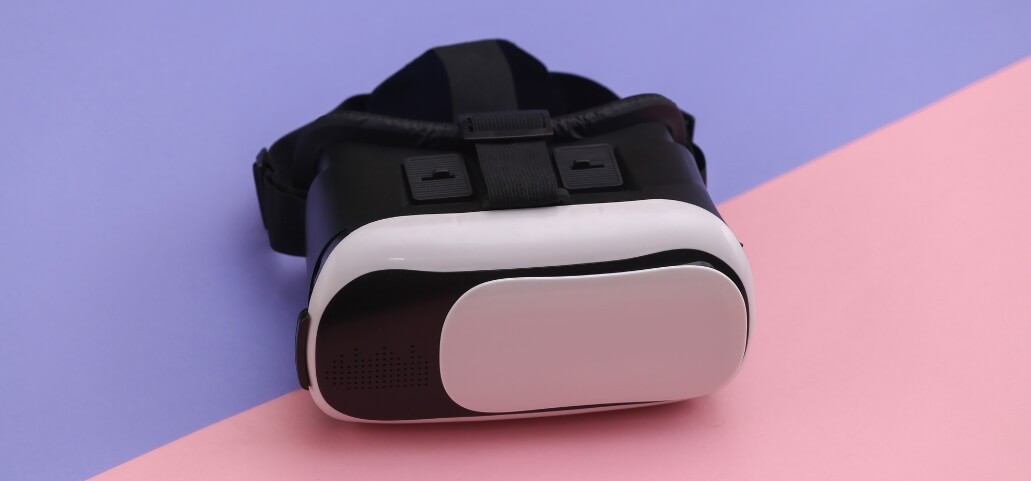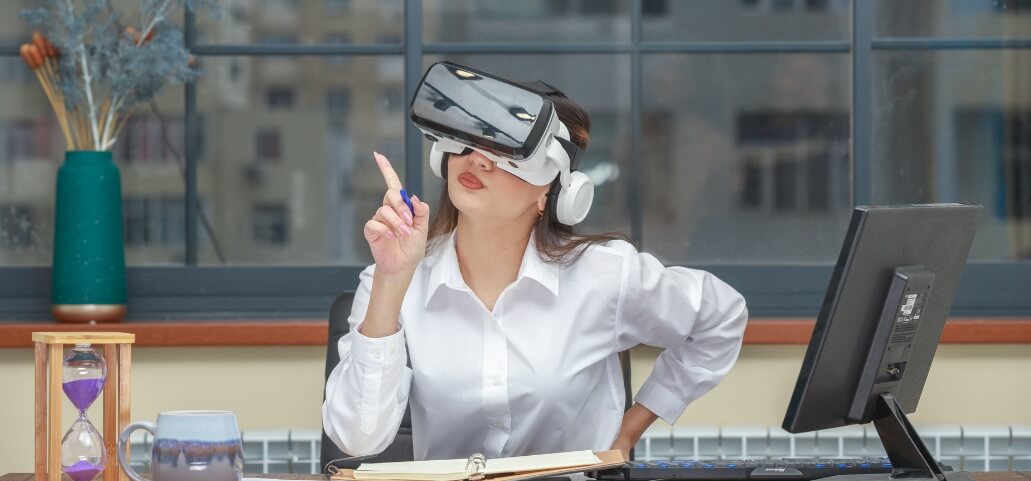Understanding how does a VR headset work involves exploring its components, from display screens and lenses to motion sensors and audio systems. Virtual Reality (VR) has revolutionized digital content, offering immersive experiences that transport users to new worlds. The VR headset combines advanced optics, motion sensors, and high-resolution displays to create a seamless virtual environment. This guide will delve into the mechanics of VR headsets, revealing how they captivate millions of users worldwide. So let’s dive in and explore how does a VR headset work.
Types of VR Headsets:
Before we delve into the workings of a VR headset, it’s important to understand the different types available in the market. Tethered, standalone, and smartphone-based virtual reality headsets are the three most common varieties.
- Tethered VR Headsets: These headsets require a connection to a PC or gaming console and provide the most immersive experience. The PlayStation VR, Oculus Rift, and HTC Vive are a few examples.
- Standalone VR Headsets: These are all-in-one devices with built-in displays and processors, eliminating the need for external connections. They offer more mobility than tethered headsets but have less powerful hardware. Examples include Oculus Quest and Lenovo Mirage Solo.
- Smartphone-based VR Headsets: These headsets use a smartphone as the display screen and rely on it for processing power. They are the most affordable option but have limited capabilities compared to the other two types. Samsung Gear VR and Google Cardboard are two examples.
Core Components of a VR Headset

A VR headset is a head-mounted device that enables users to interact with digital content in a simulated environment. It comprises several components, including:
- Display screens: The most crucial element of a VR headset is the display screen, which acts as the user’s window into the virtual world. Most VR headsets use OLED or LCD displays with high refresh rates and resolutions to create smooth visuals.
- Lenses: Lenses are placed between the eyes and display screens, helping to focus light rays from the screens directly onto each eye. They also adjust the focal length, making it easier for people with varying visual acuity to use VR headsets.
- Motion sensors: VR headsets have built-in motion sensors, including accelerometers and gyroscopes, which detect movement. These sensors are crucial in tracking the user’s head movements and rendering them into the virtual environment.
- Audio system: A good audio system is essential for creating an immersive experience in a VR headset. Most models have built-in headphones or earbuds that provide 3D spatial sound, making the virtual world feel more realistic.
How Does a VR Headset Create a Virtual Environment?
The combination of these components enables VR headsets to create a simulated reality by displaying digital content that responds to the user’s movements. Here’s how it works:
- The VR headset displays two images, one for each eye, in rapid succession. These images are carefully calibrated to ensure they are in sync and provide a seamless visual experience.
- These images are slightly different and correspond to the left and right eye views, simulating the natural disparity between what each eye sees and helping to create a sense of depth.
- The lenses in the headset help create a 3D effect by focusing these images directly onto each eye. These lenses are typically adjustable to cater to different users’ eye distances, ensuring clarity and comfort.
- To further immerse the user, the display is adjusted in real-time in response to head movements detected by the integrated motion sensors. These sensors include accelerometers, gyroscopes, and sometimes external tracking cameras to provide precise motion tracking.
Together, these components work harmoniously to trick the brain into perceiving a digital environment as a real, interactive space, enhancing the user’s experience and truly immersing them in the virtual world.
Advancements in VR Headset Technology
VR headset technology has come a long way since its inception, and new developments continue to push the boundaries of what’s possible. Some of these advancements include:
- Higher resolution displays: Newer VR headsets use higher resolution displays, resulting in sharper and more realistic visuals.
- Eye-tracking technology: Some models now have eye-tracking technology that can detect where the user is looking, allowing for more precise movements and interactions within the virtual environment.
- Wireless capabilities: Tethered headsets are becoming more wireless, eliminating the need for cumbersome cables and providing more freedom of movement.
- Hand-tracking technology: With hand-tracking technology, players may engage with the virtual world in a more organic and lifelike way, without the need for controls.
How Does a VR Headset Work in Different Sectors

VR headsets have applications in various industries, including gaming, education, healthcare, and architecture. Here are some examples of how VR headsets are used:
- Gaming: By allowing gamers to experience games in a more lifelike and engaging manner, virtual reality headsets have completely transformed the gaming business. Players can step into the game world, interact with their environment, and feel a greater sense of presence, making gaming more engaging and thrilling.
- Education: VR headsets can enhance learning by transporting students to different historical or geographical locations, making lessons more engaging and interactive. Students can experience ancient civilizations, explore the depths of the ocean, or even travel to outer space, thus enriching their understanding and retaining more information.
- Healthcare: VR technology is being used in medical training and therapy sessions to simulate real-world scenarios and improve patient outcomes. Surgeons can practice complex procedures in a risk-free environment, while patients with PTSD or phobias can undergo therapy in a controlled, virtual setting, leading to better treatment results.
- Architecture: Using virtual reality headsets, architects may better collaborate on projects by seeing their ideas in a digital setting. In order to get clients’ opinions before building starts, virtual tours of the prospective house or business are available. This improves the flow of information, cuts down on mistakes, and guarantees that the end product is exactly what the customer envisioned.
Practical Applications of VR Headsets
Apart from entertainment and education, VR headsets have practical uses in other fields. Some examples include:
- Product design: Companies use VR headsets to test designs in a virtual environment, allowing designers and engineers to visualize and interact with creations in 3D. This saves time and money on physical prototypes and enables real-time iterative improvements, leading to market-ready products.
- Military training: VR simulates combat scenarios for military training, allowing soldiers to experience realistic battlefield conditions, practice maneuvers, and improve decision-making skills in a safe environment, enhancing preparedness without the risks of live training.
- Sports training: Athletes use VR headsets to practice skills without injury risk. The technology allows them to simulate game scenarios, analyze performance, and receive instant feedback, leading to better technique, mental preparation, and overall performance.
- Education: VR transforms learning with immersive experiences that engage students more than traditional methods. From virtual field trips to interactive simulations, VR enhances education.
- Healthcare: Virtual reality (VR) provides a controlled environment for experts to refine their abilities, making it useful for pain treatment, therapy sessions, and surgical training.
- Architecture and Design: VR lets architects and designers create virtual models of projects, allowing clients to experience the design before it’s built, identifying potential issues and making real-time changes.
Tips for Choosing a VR Headset
If you’re considering purchasing a VR headset, here are a few tips to keep in mind:
- Consider your budget: VR headsets range from affordable smartphone-based options to high-end models. Determine your budget beforehand, as this will influence the features and quality you can expect. Mid-range options often balance cost and performance.
- Research the features: Headsets offer various features like hand-tracking, wireless capabilities, or higher resolution displays. Some include built-in headphones and an enhanced field of view. Compare these features to find one that suits your needs, whether you’re a casual gamer or a VR enthusiast.
- Check compatibility: Ensure the VR headset is compatible with your device or console. Some high-end headsets need powerful gaming PCs, while others work with standalone systems or specific consoles. Check software compatibility to ensure your preferred games and applications are supported.
- Comfort and fit: VR sessions can be lengthy, so comfort is key. Look for headsets with adjustable straps, breathable padding, and a lightweight design. If you wear glasses, find models that accommodate them well.
- Explore content availability: Consider the content ecosystem of the VR headset. Some platforms offer a wide range of games, educational experiences, and creative applications, while others have a limited selection. A rich library of content will maximize your VR investment.
Conclusion
Comprehension of how does a VR headset work opens up a world of possibilities for tech enthusiasts, educators, gamers, early adopters, and innovators. From their core components to the different types available, each aspect plays a crucial role in delivering immersive virtual experiences. The future of VR technology promises even more exciting advancements, making it an essential tool for various industries.
Frequently Asked Questions
Q1. How does a VR headset work without any hassle?
Answer: A VR headset uses a combination of motion sensors, high-resolution displays, and advanced optics to create an immersive experience. The sensors track the user’s movements and adjust the visuals accordingly, while the optics focus and align the images for each eye.
Q2. How does eye-tracking enhance the VR experience?
Answer: Eye-tracking technology significantly enhances performance and realism by dynamically rendering only the parts of the virtual environment that are in focus. This not only reduces the processing power required but also provides a more immersive experience by ensuring that the visuals align with the user’s gaze.
Q3. Can VR be used for educational purposes?
Answer: Yes, VR offers transformative educational experiences. It allows students to explore historical sites in 3D, take virtual field trips to places they could never visit in person, and conduct science experiments safely and realistically. This immersive learning helps in better retention and understanding of complex subjects.
Q4. What should I consider when choosing a VR headset?
Answer: When choosing a VR headset, consider several essential factors. Compatibility with your existing hardware is vital. Performance elements, such as resolution for image clarity and refresh rate for smooth motion, are also important. Additionally, assess the availability of content and applications to ensure the headset supports the experiences you seek.
Q5. Is VR only for gaming?
Answer: VR is not just for gaming; its applications span numerous industries. In education, VR fosters immersive learning environments. In healthcare, it’s utilized for therapy, surgical training, and patient education. The entertainment industry harnesses VR for movies and interactive experiences. This versatile tool is revolutionizing various fields.
Disclaimer: The data presented in this blog article is intended for purely informative reasons. We make every effort to ensure that the information is accurate and up-to-date, but we cannot guarantee or guarantee that the information is complete, accurate, reliable, suitable, or available in any way. Everything is provided in good faith.
Personal Experience: Having experimented with various VR headsets over the years, I can confidently say that the technology has come a long way. My first experience with a smartphone-based headset was intriguing but limited. However, transitioning to a standalone headset like the Oculus Quest opened up a world of possibilities. The freedom of movement and the quality of the experiences were truly remarkable. I’m really looking forward to seeing where virtual reality takes us since it might completely change the way we engage with digital information.
Why Trust Our Content?
Our content is crafted by experts with years of experience in the tech industry. We stay updated with the latest trends and advancements in VR technology to provide you with accurate and reliable information. We also test and review various VR headsets to offer firsthand insights and recommendations. Our goal is to help you make informed decisions and get the most out of your VR experience.

